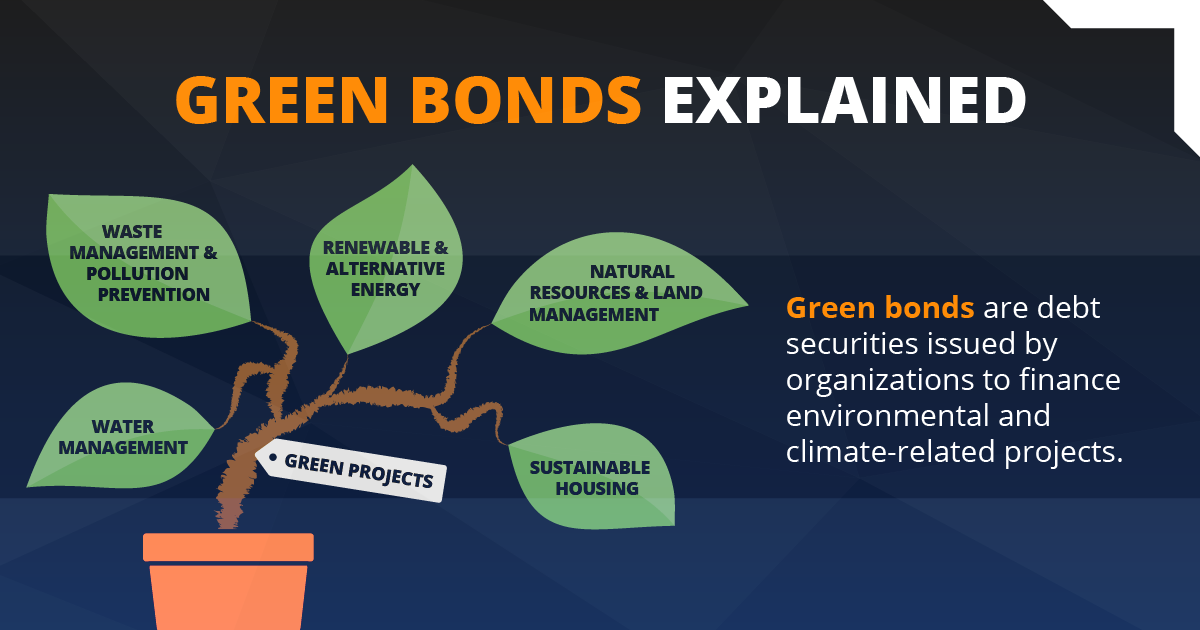Green Bonds
August 19, 2021
What is a “Green Bond”?
Green bonds are fixed income securities that are issued by organisations in order to raise capital for environmental and climate projects. They are also known as “climate bonds” and are usually backed by the issuing entity’s assets. Therefore, green bonds are likely to carry the same credit rating as other debt securities issued by the same organisation. Some of them are designed to offer tax advantages, which makes them attractive relative to taxable bonds.
Key Learning Points
- Green bonds are debt securities issued by organizations to finance environmental and climate-related projects.
- The first ever officially labelled “green” bond was issued by the World Bank in 2008.
- Also known as “climate bonds”, they are designed to offer tax incentives, which makes them appealing even to investors without ethical preferences.
- Most green bonds are asset-backed and the investors are promised that all raised capital will only be allocated towards specific climate-related projects.
- “Green” can include projects like renewable energy, sustainable infrastructure and clean transportation.
How Green Bonds Work

Technically, green bonds are structured and work in the same way as conventional bonds – the investor becomes the creditor of the issuing organisation and receives the principal amount when the bond matures, in addition to the regular interest payments throughout its term.
Supranational organisations, sovereign governments, companies and financial institutions can all issue such securities. However, green bonds are specifically issued to fund environmental and climate-related projects, while conventional bonds are usually issued to raise capital for general projects or refinancing existing debt. Some of these projects include:
- Renewable/alternative energy
- Waste management and pollution prevention
- Water management
- Natural resources and land management
- Sustainable housing
Another feature of green bonds is that third-party verifiers, such as the Climate Bond Standard Board, are used to confirm the bond’s legitimacy and provide investors with assurance.
Advantages of Investing in Green Bonds
With the rising popularity of ESG (Environmental, Social and Governance) investing, green bonds have experienced rapidly increasing demand, driven primarily by ethical considerations rather than pursuing maximum financial return. In addition to their non-financial benefits, climate bonds offer tax advantages (depending on the issuer and local jurisdictions), such as tax exemptions.
What are the Risks?
One of the major risks involved when investing in green bonds is liquidity. Despite the fact that this market has grown significantly over the last decade, it is still very small relative to other asset classes. As a result, it might be difficult to sell an already purchased security and investors may need to hold it until maturity instead. Although serious efforts have been made to clearly outline the definition of green bonds, investors might still face misleading statements and lack of detail.
This type of bond normally produces lower yields and is positively correlated to the performance of the alternative energy segment. Therefore, usually cheaper oil and energy prices lead to lower demand for alternative energy and as a result of that green bonds could in theory suffer. However, as governments around the world are putting an ever increasing focus on climate-related issues, it is likely that the support for green bonds will only get stronger.

